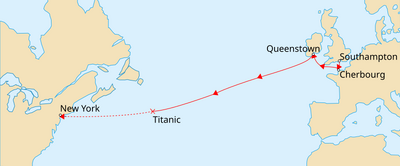
Nicholas de Brabant was one of the passengers on board the Titanic for her doomed maiden voyage.
The RMS Titanic was a passenger liner owned by the White Star Line. For her time, she was the largest passenger steamship in the world. On the night of 14 April 1912, during her maiden voyage, the ship hit an iceberg. She sank early the following morning, resulting in the deaths of 1,517 people—one of the most deadly peacetime maritime disasters in history.
On board the Titanic on this doomed voyage was Nicholas de Brabant, better known to viewers of Forever Knight as Det. Nick Knight.
As told in the flashback scenes in the episode "Black Buddha, Pt. Two", Nick is approached during the voyage by another passenger, Claire Gibson, who flirtatiously reveals that she knows he is a vampire.

In her large stateroom on the Titanic, Claire Gibson shows Nick the "Black Buddha" statuette.
She takes him back to her well-appointed stateroom, where she tells him the history of a reputedly magical statuette of the Buddha that grants its owner's dearest wish. She offers to give it to him if he brings her over.
However, the "Black Buddha" is supposed to have a curse on it. When the Titanic hits an iceberg and starts to sink, Claire is sure that this is the curse at work. When she is told that there are not enough lifeboats to save more than half the people on board, she feels that this disaster is her fault for making a wish on the Buddha. She therefore changes her mind and asks Nick to kill her instead.
Description of the Ship[]

The Titanic departs Southampton on her maiden voyage.
The Titanic was a White Star Line ocean liner, built at the Harland and Wolff shipyard in Belfast. She was designed to compete with the rival Cunard Line's Lusitania and Mauretania. Construction began in 1909. The hull was launched two years later, and outfitting was completed by 31 March 1912. The ship was slightly over 882 feet (269.1 m) long, and could carry a total of 3,547 passengers and crew.
The Titanic surpassed all rivals in luxury and opulence. She offered an on-board swimming pool, a gymnasium, a Turkish bath, a squash court, and libraries in both the first and second-class sections. First-class common rooms were adorned with ornate wood panelling and expensive furniture. The passengers paid a hefty fee for such amenities. The most expensive one-way trans-Atlantic passage was $4,350—more than $80,000 in today's currency.
Because the Titanic carried mail, her name was given the prefix RMS (Royal Mail Steamer) as well as SS (Steam Ship).
The Voyage[]
The Titanic began her maiden voyage from Southampton, England, bound for New York City, U.S.A., on Wednesday, 10 April 1912, with Captain Edward J. Smith in command.

Capt. Edward J. Smith
After crossing the English Channel, the Titanic stopped at Cherbourg, France, to board additional passengers and stopped again the next day in Ireland. When she finally set out for New York, there were 2,240 people aboard. These included some of the most prominent people of the day, travelling in first–class.
On Sunday, 14 April 1912, several messages about icebergs were sent by other ships; but they were not relayed to the bridge, since the wireless radio operators were employed by Marconi Company, which paid them to relay messages to and from the passengers. The operators considered the ice messages to be "non-essential".
Sinking of the Titanic[]
Just before midnight, a large iceberg was spotted directly ahead of the ship. A collision was inevitable. It brushed the ship's starboard side, buckling the hull in several places. Seawater filled the forward compartments; and watertight doors in the hull (a safety feature) automatically shut. However, although the ship could stay afloat with four flooded compartments, there were actually five that were filling with water. These so weighed the ship down that the tops of the forward watertight bulkheads fell below the ship's waterline, allowing water to pour into additional compartments. Captain Smith arrived on the bridge and ordered a full stop.
Shortly after midnight on 15 April, the lifeboats were ordered to be readied and a distress call was sent out. Several ships responded, but none was close enough to make it to the Titanic before she sank. The closest ship to respond was Cunard Line's Carpathia, which arrived in about four hours—too late to rescue all of the passengers.

The route of the Titanic. The X marks the approximate location where she sank, with the remaining (uncompleted) route shown as a dashed line.
The Titanic carried twenty lifeboats with a total capacity of 1,178 persons. It needs to be noted that, while these were not enough to hold all of the passengers and crew, the Titanic did actually carry more boats than were required by the British Board of Trade Regulations. At the time, the number of lifeboats required was determined by a ship's tonnage, rather than the number of people she could carry.
Initially, the Titanic showed no outward signs of being in imminent danger; and passengers were reluctant to leave the apparent safety of the ship to board small lifeboats. Furthermore, the ships' officers more or less followed a policy of "Women and children first", preventing many men from boarding the lifeboats even when there was room. As a result, most of the boats were launched partially empty.
Around 02:10, the stern rose out of the water, and a few minutes later the waterline reached the boat deck. The last two lifeboats floated off the deck. On deck, people scrambled towards the stern or jumped overboard. The ship's stern slowly rose into the air. Shortly afterwards, the stress on the hull caused the ship to break apart, and the bow went completely under. The stern rose vertically; and then, after a few moments, it too sank into the ocean.
- Adapted from the Wikipedia article on the Titanic.